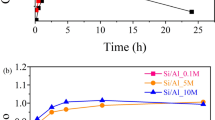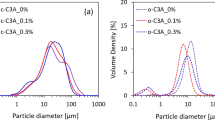Abstract
The hydration of periclase to brucite was investigated experimentally. Single crystals of periclase machined to millimeter sized cubes with (100) surfaces were reacted with distilled water at temperatures of 350 to 620 ∘C and a pressure of 200 MPa for run durations of 5 to 40 minutes. Hydration produced a layer of brucite covering the surface of periclase. While the shrinking periclase largely retained its cube shape a surface roughness developed on the μm scale and eventually outward pointing spikes bounded by (111) faces emerged on the retreating faces of the periclase due to kinetic selection of less reactive (111) and (110) surfaces. The periclase to brucite conversion followed a linear rate law, where the reaction rate increased from 350 to 530 ∘C and then decreased towards higher temperature and finally vanished at about 630 ∘C, where periclase, brucite, and water are in equilibrium at 200 MPa. The overall kinetics of the hydration reaction is conveniently described in terms of a phenomenological interface mobility. Measuring the velocity of the hydration front relative to the lattice of the reactant periclase, the temperature dependence of its mobility is described by an Arrhenius relation with pre-exponential factor 1.7.10−12 m 4/s.J and activation energy of E A =55 kJ/mol.






Similar content being viewed by others
References
Birchal VS, Rocha SDF, Mansur MB, Ciminelli VST (2001) A simplified mechanistic analysis of the hydration of magnesia. Can J Chem Eng 79(4):507–511
Blaha J (1995) Kinetics of hydration of MgO in aqueous suspension. Ceram Silik 39(2):41–80
Brady JB (1983) Intergranular diffusion in metamorphic rocks. Am J Sci 283-A:181–200
Bratton R, Brindley G (1965) Kinetics of vapor-phase hydration of magnesium part ii. Trans Faraday Soc 61:1017–1025
Bugajski J, Gamsjger H (1983) Osterr Chem Z 9:214
Etheridge MA, Wall VJ, Vernon RH (1983) The role of the fluid phase during regional metamorphism and deformation. J Metamorph Geol 1(3):205–226
Feitknecht W, Braun H (1967) Der mechanismus der hydratation von MgO mit wasserdampf. Helvetica Chimica Acta 50(211):2040–2053
Filippou D, Katiforis N, Papassiopi N, Adam K (1999) On the kinetics of magnesia hydration in magnesium acetate solutions. J Chem Technol Biotechnol 74(4):322–328
Fruhwirth O, Herzog GW, Hollerer I, Rachetti A (1985) Dissolution and hydration kinetics of MgO. Surface Technology 24(3):301–317
Gerya TV, Yuen DA, Sevre EOD (2004) Dynamical causes for incipient magma chambers above slabs. Geology 32(1):89–92
Heidberg B, Bredow T, Littmann K, Jug K (2005) The structure and reaction of water layers on magnesium oxide. A cylic cluster study. Mater Sci Pol 23:501–508
Holland TJB, Powell R (1998) An internally consistent thermodynamic data set for phases of petrological interest. J Metamorph Geol 16(3):309–343
Jamtveit B, Austrheim H (2010) Metamorphism: the role of fluids. Elements 6(3):153–158
Jug K, Heidberg B, Bredow T (2007) Cyclic cluster study on the formation of brucite from periclase and water. J Phys Chem C 111(35):13,103–13,108
Jura G, Garland C (1952) The experimental determination of the surface tension of magnesium oxide. J Am Chem Soc 74(23):6033–6034
Kennedy GC (1956) The brucite-periclase equilibrium. Am J Sci 254(9):567–573
Langel W, Parrinello M (1994) Hydrolysis at stepped mgo surfaces. Phys Rev Lett 73(3):504–507
Layden GK, Brindley GW (1963) Kinetics of vapor-phase hydration of magnesium oxide. J Am Ceram Soc 46(11):518–522
Mejias JA, Berry AJ, Refson K, Fraser DG (1999) The kinetics and mechanism of MgO dissolution. Chem Phys Lett 314(5-6):558–563
Nakanishi K, Fukuda T, Nomura J (1989) Formation mechanism of Mg(OH)2 prepared by hydration of magnesia clinker in magnesium salt solution (part 1) - kinetics. Nippon Seramikkusu Kyokai Gakujutsu Ronbunshi-J Ceram Soc Jap 97(7):683–689. (In Japanese with English abstract)
Ostapenko G (1976) Excess pressure on the solid phases generated by hydration(according to experimental data on hydration of periclase). Geokhimiya 6:824–844
Oviedo J, Calzado CJ, Sanz JF (1998) Molecular dynamics simulations of the MgO(001) surface hydroxylation. J Chem Phys 108(10):4219–4225
Refson K, Wogelius RA, Fraser DG, Payne MC, Lee MH, Milman VV (1995) Water chemisorption and reconstruction of the MgO surface. Phys Rev B Condens Matter 52 (15):10,823–10,826
Robie R, Hemingway B, Fisher J (1979) Thermodynamic properties of minerals and related substances at 298.15k and 1 bar (105 pascals) pressure and at higher temperatures. Geological Survey Bulletin, 1452
Rocha SDF, Mansur MB, Ciminelli VST (2004) Kinetics and mechanistic analysis of caustic magnesia hydration. J Chem Technol Biotechnol 79(8):816–821
Sangwal K, Patel T, Kotak M (1979) On the kinetics and mechanism of dissolution of MgO crystals. J Mater Sci 14(8):1869– 1876
Saylor D, Mason D, Rohrer G (2000) Experimental method for determining surface energy anisotropy and its application to magnesia. J Am Ceram Soc 83(5):1226–1232
Smith JM (1981) Chemical engineering kinetics, 3rd edition. McGraw-Hill, New York
Smithson G, Bakhshi N (1969) The kinetics and mechanism of the hydration of magnesium oxide in a batch reactor. Can J Chem Eng 47:508–513
Snedecor G, Cochran W (1980) Statistical methods, 7th edition. Iowa State University Press, Ames, p 342
Stirniman MJ, Huang C, Smith RS, Joyce SA, Kay BD (1996) The adsorption and desorption of water on single crystal mgo(100): the role of surface defects. J Chem Phys 105 (3):1295–1298
Ulven OI, Storheim H, Austrheim H, Malthe-Sorenssen A (2014) Fracture initiation during volume increasing reactions in rocks and applications for CO2 sequestration. Earth Planet Sci Lett 389 :132–142
Wogelius RA, Refson K, Fraser DG, Grime GW, Goff JP (1995) Periclase surface hydroxylation during dissolution. Geochim Cosmochim Acta 59(9):1875–1881
Yardley BWD, Rhede D, Heinrich W (2014) Rates of retrograde metamorphism and their implications for the rheology of the crust: an experimental study. J Petrol 55(3):623– 641
Zhang ZP, Zhang C, Huang DX, Jiang DY, Zhang RJ, Yun Z (2010) The exploring research of the determination method of magnesium oxide hydration. Adv Mater Res 177:342–345
Zheng YF (2009) Fluid regime in continental subduction zones: petrological insights from ultrahigh-pressure metamorphic rocks. J Geol Soc 166(4):763–782
Zhou S (2004) Hydration mechanisms of magnesia-based refactory bricks. PhD thesis
Acknowledgments
Financial support by the Austrian Science Foundation project I-474 N19 in the framework of the FWF-DFG DACH research group FOR 741 and by University of Vienna in the framework of the doctoral school IK 053 on “Deformation of geological materials: mechanical-chemical feedback and the coupling across scales” is gratefully acknowledged. The authors are indebted to Ralf Milke for efficient handling of and constructive comments on the manuscript.
Author information
Authors and Affiliations
Corresponding author
Additional information
Editorial handling: R. Milke
Rights and permissions
About this article
Cite this article
Kuleci, H., Schmidt, C., Rybacki, E. et al. Hydration of periclase at 350 ∘ C to 620 ∘ C and 200 MPa: experimental calibration of reaction rate. Miner Petrol 110, 1–10 (2016). https://doi.org/10.1007/s00710-015-0414-2
Received:
Accepted:
Published:
Issue Date:
DOI: https://doi.org/10.1007/s00710-015-0414-2




